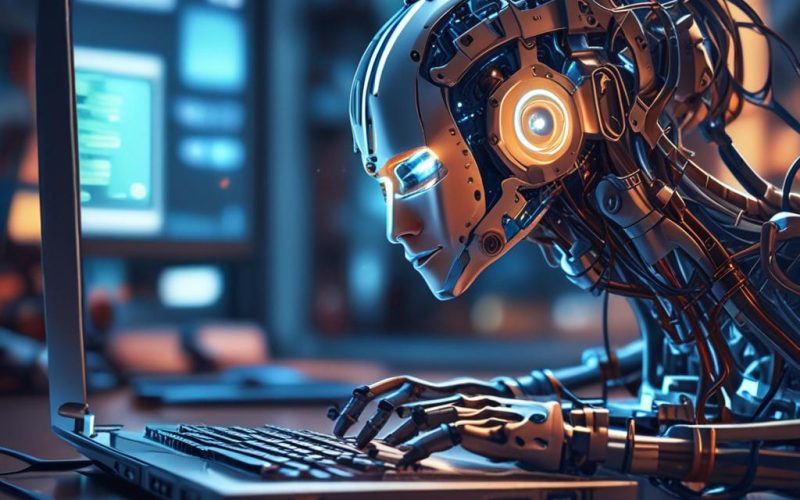Table of Contents Show
Imagine teaching a computer to recognize cats in photos without explicitly telling it what a cat looks like. Sounds magical, right? That’s essentially what machine learning does—it enables systems to learn from data and improve over time without being programmed for every possible scenario. Whether it’s recommending your next favorite song, translating languages in real time, or even diagnosing diseases, machine learning is the driving force behind many modern technologies. But how does it really work? In this guide, we’ll break down the fundamentals of machine learning in simple, beginner-friendly terms.
Step-by-Step Process
Collect Data
Gather relevant data for training the model.
Preprocess Data
Clean and format data to improve model accuracy.
Choose Algorithm
Select a suitable ML algorithm for the task.
Train Model
Feed data to the algorithm to learn patterns.
Evaluate & Deploy
Test model performance and implement it.
Process infographic for How Does Machine Learning Work? Simple Explanation for Beginners
Main Components of Machine Learning
Machine learning relies on three core elements: data, algorithms, and models. Together, they allow systems to learn patterns, make predictions, and adapt to new information.

The Role of Data
Data is the fuel that powers machine learning. It can come in various forms—numbers, text, images, or even video. For example, if you’re training a model to recognize handwritten digits, you’d feed it thousands of labeled images of numbers. The quality and quantity of data directly impact how well the model performs.
Algorithms: The Learning Rules
Algorithms are the step-by-step instructions that tell the computer how to learn from the data. Different algorithms are suited for different tasks. For instance, a decision tree algorithm might be used to classify emails as spam or not spam, while a neural network could help a self-driving car recognize stop signs.
Models: The Output of Learning
Once an algorithm processes the data, it creates a model—a set of learned patterns or relationships. This model can then make predictions on new, unseen data. For example, a model trained on customer purchase history might predict which products a user is likely to buy next.
How Machine Learning Works: Step by Step
Machine learning isn’t just about feeding data into a computer and hoping for the best. It involves a structured process to ensure accurate and reliable results.
Step 1: Define the Problem
Before anything else, you need a clear goal. Are you trying to predict stock prices, classify images, or recommend movies? Defining the problem helps choose the right type of machine learning—supervised, unsupervised, or reinforcement learning.
Step 2: Collect and Prepare Data
Data collection is followed by cleaning and preprocessing. Missing values are filled, irrelevant information is removed, and data is formatted consistently. For example, if training a model to recognize faces, you’d ensure all images are the same size and resolution.
Step 3: Choose an Algorithm
The choice of algorithm depends on the problem. Linear regression might be used for predicting continuous values (like house prices), while logistic regression could classify data into categories (like yes/no). More complex problems may require deep learning algorithms like CNNs for image recognition.

Step 4: Train the Model
During training, the algorithm analyzes the data and adjusts its internal parameters to minimize errors. For instance, if the model predicts a house price incorrectly, it tweaks its calculations until the prediction aligns with the actual price.
Step 5: Evaluate and Improve
After training, the model is tested on new data to measure its accuracy. If performance is poor, the algorithm may need to be adjusted, more data collected, or different features considered. This iterative process continues until the model meets desired standards.
Step 6: Deploy and Monitor
Once satisfied, the model is deployed into real-world applications. However, monitoring is crucial—performance can degrade over time as new data patterns emerge. Regular updates and retraining ensure the model stays effective.
Types of Machine Learning
Machine learning isn’t one-size-fits-all. Different approaches are used depending on the task and available data.
Supervised Learning
In supervised learning, the model is trained on labeled data—meaning each input has a corresponding correct output. For example, a dataset of labeled cat and dog images helps the model learn to distinguish between the two. Common supervised learning algorithms include:
- Linear Regression
- Decision Trees
- Support Vector Machines (SVM)
Unsupervised Learning
Here, the model works with unlabeled data and must find patterns on its own. Clustering algorithms, like K-means, group similar data points together without prior guidance. This is useful for market segmentation or identifying anomalies in fraud detection.
Reinforcement Learning
This type involves training models through trial and error, using rewards and penalties. A classic example is teaching an AI to play chess—it learns by receiving positive feedback for good moves and negative feedback for bad ones.

Real-World Applications of Machine Learning
Machine learning isn’t just a theoretical concept—it’s already transforming industries.
Healthcare
AI models analyze medical images to detect tumors, predict disease outbreaks, or personalize treatment plans. For example, Google’s DeepMind can interpret eye scans to detect diabetic retinopathy.
Finance
Banks use machine learning to detect fraudulent transactions, assess credit risks, and even automate trading decisions. Algorithms analyze vast amounts of transaction data to spot suspicious patterns.
E-commerce
Recommendation systems powered by machine learning suggest products based on past behavior. Netflix suggests shows you might enjoy, while Amazon recommends items similar to your recent purchases.
Autonomous Vehicles
Self-driving cars rely on machine learning to interpret sensor data and make real-time decisions. Models classify objects (pedestrians, traffic lights) and predict their movements to navigate safely.
Conclusion
Machine learning is a powerful tool that enables computers to learn from data and improve without explicit programming. By understanding its core components—data, algorithms, and models—you can appreciate how it powers everything from voice assistants to medical diagnostics. Whether you’re a curious beginner or looking to dive deeper, the key takeaway is this: machine learning is all about making sense of data to solve real-world problems. Ready to explore further? The world of AI awaits!




